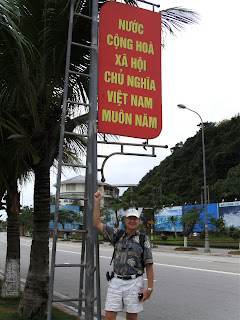
This is my last post because tomorrow we’ll be pulling into Civitavecchia (the harbor for Rome) at oh-dark-thirty and we’ll be shuffled off this ship as fast as the crew can haul our luggage ashore. I have no idea if I’ll have Internet access in Rome, or even the time to write if I do have access, so this is my swan song blog. That’s the bad news.
The good news is this last port is by far and away our favorite. Without a doubt, the word for Sorrento, and all of the Amalfi Coast is HEAVEN. I’ve decided to be really, really good for the rest of my days so I’ll be allowed to spend eternity here. Everything you’ve ever heard about this part of the world is true: the sky is bluer, the water is clearer, the architecture prettier, the food better. Italians may be goofy about their homeland, but doggone it, they certainly have a right to be.
Coming into port this morning was like drifting into a movie set for a film starring Sophia Loren and Ricardo Montalban (remember the guy who crooned about “rich, Corinthian leather” for Chrysler and later was the king of Fantasy Island?) Anyway, it was romance, romance, romance everywhere we looked. Gleaming white yachts in the harbor, steep granite cliffs topped by ochre-colored villas (actually hotels, but they look “villa-ish”), and lush landscape including palm trees (my favorite) and bougainvillea (Tom’s favorite). Coming ashore it just kept getting better: the steep winding roads were all cobblestone with a zillion scooters zipping up them like bees returning to the hive. We climbed on the bus to take us to the main town square (you can walk up a steep stone staircase, but I wanted to save our strength for the top) and they packed us in so tight a pickpocket could have stolen my bra and I’m sure I wouldn’t have noticed. The square was a bit crowded but who cares? It was gorgeous. Little shops and cafés ring the square and everybody’s smiling. You don’t get the same feeling here that we had in the Middle East where it’s sort of an “us” vs. “them” mentality—with the locals vying for our very last dime and us clutching our wallets like we were at an IRS audit. Nope. Here everyone seems to have reached an agreement: this is paradise and we’re all darn lucky to be here. Regardless of whether you’re a visitor or a local, this is a terrific day and we’re all just going to make the most of it.
We walked through the town and bought some crazy souvenirs and then sat in a café and had a cappuccino right outside a staggeringly beautiful church where a couple was getting married. They came out after the lengthy mass and proceeded to walk throughout town with photographers trailing behind, taking artsy photos of them in different venues: quaint shops, bakeries, dazzling harbor views, and so on. I couldn’t believe that the bride hoofed it along blocks and blocks of cobblestone streets (weaving in and out of hordes of tourists) in her obviously gazillion-euro beaded gown with ten-foot train. She played the good sport for the photographers who seemed bent on getting at least a hundred photos, smiling the whole time. When I commented to Tom that it was going to cost a small fortune to clean that white satin gown, he said, “like she’s ever going to wear it again?” He’s right. Everyone here is living in the moment, and seeming to enjoy every second.
In that vein, we joined in the fun by having a ridiculously high-priced lunch at a beautiful restaurant tucked away in the center of town. You had to go down a tiny alleyway entrance with golden walls and a low overhanging fabric ceiling to reach an oasis of calm. Once inside, the waiters did their best impression of Marcello Mastriani as they seated us and brought us a basket of the most chewy, tasty bread imaginable (4 euros—about $5 for the bread, so you can imagine the total bill!). Here’s a bit of good news: we were celebrating not only life, but a small financial windfall we never saw coming. Tom went to one bingo game on this entire leg of the cruise (30 days) and bought only one $10 ticket for one game (the BIG one). You guessed it, he won! The entire jackpot was $1,500 but he and another guy both had bingo at the same time so they split it, $750 each. So, we felt entitled to a little Italian joie de vive. We’re pretty sure the entire mother lode will be gone after three days in Rome (we’ve heard tales of $600 lunches!) but for now we feel flush.
Anyway, Sorrento was fabulous, as was this entire trip. I was a bit apprehensive at the beginning (remember me lamenting about packing for 75 days?) but I have no regrets whatsoever about doing this. It was wonderful to have seen glimpses of Australia, Micronesia, Japan, the Far East, India, the Middle East, Egypt, and now a bit of Europe. I don’t think we’ll be going back to the Far East or Middle East anytime soon, but a few weeks in the Mediterranean is definitely on our to-do list.
Thanks to all of you who’ve been loyal readers. Knowing I’d be reporting to you kept me awake during long bus tours (after all, I had to hear what the guide was saying so I’d have something to write), and kept me out of the casino (unlike Tom I rarely, if ever, win). The Internet service on this ship was weak (pathetic at times) but it was just enough to allow me to feel connected to you all.
Now it’s on to Rome and then on to home…See you soon!















